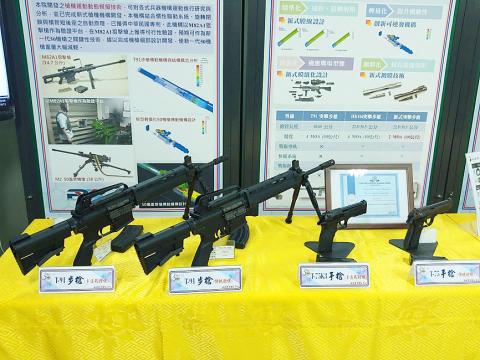New handguns and assault rifles for the armed forces are benefiting from National Defense University’s proprietary technology, a polygonal rifling that doubles the service life of barrels and more than doubles their precision, the university said.
Employed in the military’s new T75K3 pistols, polygonal rifling would also be used in the T91K3 assault rifle, which is being developed at the Armaments Bureau’s 205th Arsenal, the university said.
Rifling — a groove that spirals down the inside of a barrel — gives a bullet spin, thereby improving its aerodynamic stability and making the gun more precise at longer ranges, power vehicles and systems engineering professor Deng Shi-gan (鄧世剛) said.

Photo: Aaron Tu, Taipei Times
The inside of a barrel with conventional rifling is marked with sharp, angular indentations that cause friction and allow gas to escape, he said.
The smooth undulating grooves of polygonal rifling — the name comes from the shape of the bore, which resembles a polygon with rounded corners — gives superior wear-and-tear and gas-sealing properties, he added.
The university team used computer-aided design to make the rifling patterns to greatly extend the barrel’s service life and improve precision, Deng said, adding that the program was partially funded by the National Defense Industrial Development Foundation.
Firing the barrel at 100m would result in an average 10-shot grouping about the size of a NT$10 coin, while the barrels can be used to fire more than 20,000 bullets without any loss of accuracy, material sciences professor Liu Yi-ming (劉益銘) said.
The university and the arsenal are also jointly developing a nickel-boron finish for bolt carriers that should almost eliminate the need for rifle lubricant, Chungshan Institute of Science and Technology Commandant Major General Jing Yuan-yeu (荊元宇) said.
Compared with phosphate, nickel-boron finishes last longer and offer greater resistance to corrosion, increasing the number of rounds between malfunctions and are less harmful to the environment, Jing said.
In testing, a T91 rifle with the nickel-boron finish and no additional lubricant could fire about 10,500 rounds before jamming, he said, adding that there was no discernible damage at 8,000 rounds and the corrosion tests were promising.
The finish would make the next generation of small arms more reliable and durable, while decreasing upkeep requirements, he said.
In other news, a defense official said that the army plans to buy 10,404 T75K3 pistols at a cost of NT$368.6 million (US$12 million) to completely replace the aging Colt M1911A1 handguns in its inventory.
The M1911A1 pistols, either 60-year-old holdouts from US military aid or locally produced copies, show significant wear-and-tear, the official said on condition of anonymity.
The M1911A1 is considered an overly heavy weapon with excessive recoil and a small magazine — only seven rounds — compared with the T75K3, which has a more durable barrel and a 15-round magazine, the official said.
All of the aging pistols should be replaced by 2022, the official said.

Taiwan is to commence mass production of the Tien Kung (天弓, “Sky Bow”) III, IV and V missiles by the second quarter of this year if the legislature approves the government’s NT$1.25 trillion (US$39.78 billion) special defense budget, an official said yesterday. Commenting on condition of anonymity, a defense official with knowledge of the matter said that the advanced systems are expected to provide crucial capabilities against ballistic and cruise missiles for the proposed “T-Dome,” an advanced, multi-layered air defense network. The Tien Kung III is an air defense missile with a maximum interception altitude of 35km. The Tien Kung IV and V

The disruption of 941 flights in and out of Taiwan due to China’s large-scale military exercises was no accident, but rather the result of a “quasi-blockade” used to simulate creating the air and sea routes needed for an amphibious landing, a military expert said. The disruptions occurred on Tuesday and lasted about 10 hours as China conducted live-fire drills in the Taiwan Strait. The Civil Aviation Administration (CAA) said the exercises affected 857 international flights and 84 domestic flights, affecting more than 100,000 travelers. Su Tzu-yun (蘇紫雲), a research fellow at the government-sponsored Institute for National Defense and Security Research, said the air

Taiwan lacks effective and cost-efficient armaments to intercept rockets, making the planned “T-Dome” interception system necessary, two experts said on Tuesday. The concerns were raised after China’s military fired two waves of rockets during live-fire drills around Taiwan on Tuesday, part of two-day exercises code-named “Justice Mission 2025.” The first wave involved 17 rockets launched at 9am from Pingtan in China’s Fujian Province, according to Lieutenant General Hsieh Jih-sheng (謝日升) of the Office of the Deputy Chief of the General Staff for Intelligence at the Ministry of National Defense. Those rockets landed 70 nautical miles (129.6km) northeast of Keelung without flying over Taiwan,

City buses in Taipei and New Taipei City, as well as the Taipei MRT, would on Saturday begin accepting QR code payments from five electronic payment providers, the Taipei Department of Transportation said yesterday. The new option would allow passengers to use the “transportation QR code” feature from EasyWallet, iPass Money, iCash Pay, Jkopay or PXPay Plus. Passengers should open their preferred electronic payment app, select the “transportation code” — not the regular payment code — unlock it, and scan the code at ticket readers or gates, General Planning Division Director-General Liu Kuo-chu (劉國著) said. People should move through the